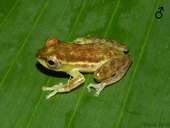|
Hyperolius fusciventris Peters, 1876
| family: Hyperoliidae genus: Hyperolius |
 © 2014 Daniel Portik (1 of 28) |
|
|
|
Description This species can be split up into three, possibly four distinct subspecies. They are regarded as subspecies in the classical sense since they are allopatric, vicariate for each other in identical habitats, have very similar voices and identical juvenile phases.
1. Hyperolius f. fusciventris. Characterised by a Phase F with ventrum dusky grey, sometimes almost white, sometimes almost black. The ventral colour is normally delimited from the flanks by an irregular black line.
2. Hyperolius f. lamtoensis Schiøtz 1965. – Characterised by phase F having a white ventrum with red marbling. No black pigmentation. The red marbling disappears after preservation.
3. Hyperolius f. burtoni (Boulenger 1883). – Characterised by phase F having a white ventrum with irregular black spots and streaks. Red and yellow markings on limbs and feet. 4. Hyperolius f. ssp. In Cameroun a distinct form of H. fusciventris, somewhat similar to the remote H. f. lamtoensis, occurs. Phase F has flanks with red and white vermiculations. Ventrum uniform red to red with whitish central region. Red vermiculation on throat. This form seems to represent a distinct, unnamed subspecies. The tadpole has the usual tooth formula of 1/1+1,2 or 1/3. Distribution and Habitat Country distribution from AmphibiaWeb's database: Benin, Cameroon, Cote d'Ivoire, Ghana, Guinea, Liberia, Nigeria, Sierra Leone
Life History, Abundance, Activity, and Special Behaviors The eggs are quite heavily pigmented, with a dark and a light pole. Jelly clear. They are placed above water. Comments This account was taken from "Treefrogs of Africa" by Arne Schiøtz with kind permission from Edition Chimaira publishers, Frankfurt am Main.
References
Schiøtz, A. (1999). Treefrogs of Africa. Edition Chimaira, Frankfurt am Main. Originally submitted by: Arne Schiøtz (first posted 2001-01-09) Edited by: Kellie Whittaker (2008-09-10) Species Account Citation: AmphibiaWeb 2008 Hyperolius fusciventris <https://amphibiaweb.org/species/531> University of California, Berkeley, CA, USA. Accessed Feb 17, 2025.
Feedback or comments about this page.
Citation: AmphibiaWeb. 2025. <https://amphibiaweb.org> University of California, Berkeley, CA, USA. Accessed 17 Feb 2025. AmphibiaWeb's policy on data use. |



 Map of Life
Map of Life